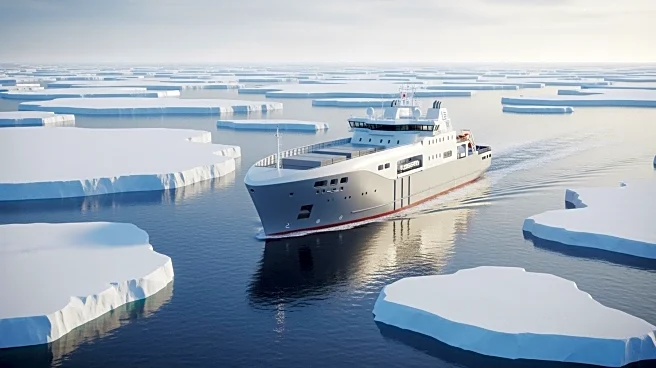What's Happening?
A Chinese container ship, the Istanbul Bridge, has completed a groundbreaking voyage from China to Europe via the Arctic, marking the first use of the 'Ice Silk Road' for container shipping. The ship departed from Ningbo-Zhoushan in China on September
23 and reached its first stop in Felixstowe, UK, in just 20 days, faster than the traditional Suez Canal route. The journey continued through Hamburg, Germany, and Gdansk, Poland, with the ship expected to arrive in Rotterdam, Netherlands. This Arctic route, accessible only a few months per year, offers a faster alternative to traditional shipping lanes, reducing delivery times and facilitating trade between China and Europe.
Why It's Important?
The successful completion of the Arctic route by the Istanbul Bridge highlights the potential for new shipping corridors as climate change reduces Arctic ice coverage. This development could revolutionize global trade by providing faster and more efficient routes, particularly for sensitive cargo. The Arctic passage is two weeks faster than the Suez Canal route and half the time of the Cape of Good Hope route, offering significant advantages for shipping high-tech and high-value goods. As the Arctic becomes more navigable, it may also become a strategic area in the U.S.-China rivalry, with implications for global security and trade dynamics.
What's Next?
The Arctic route's success may encourage more shipping companies to explore this corridor, potentially increasing trade between China and Europe. As ice coverage continues to shrink, the route could become a regular option for transporting goods, particularly electronics and other sensitive cargo. The development of the 'Ice Silk Road' under China's Belt and Road Initiative may further enhance China's trade influence in Europe. Additionally, the Arctic's strategic importance may grow, with increased presence from China and Russia, impacting geopolitical dynamics and security considerations in the region.
Beyond the Headlines
The opening of the Arctic route for container shipping has broader implications for environmental and geopolitical issues. As climate change makes the Arctic more accessible, it raises questions about the environmental impact of increased shipping activity in the region. The route's development also reflects China's strategic ambitions under the Belt and Road Initiative, aiming to enhance its trade connectivity and influence. Furthermore, the Arctic's emerging role in global trade may lead to increased international cooperation and competition, as countries navigate the challenges and opportunities presented by this new shipping corridor.















